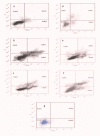The Potential of Optimized Liposomes in Enhancement of Cytotoxicity and Apoptosis of Encapsulated Egyptian Propolis on Hep-2 Cell Line
- PMID: 34959465
- PMCID: PMC8704699
- DOI: 10.3390/pharmaceutics13122184
The Potential of Optimized Liposomes in Enhancement of Cytotoxicity and Apoptosis of Encapsulated Egyptian Propolis on Hep-2 Cell Line
Abstract
Purpose: Development of pharmaceutical dosage forms of natural products has gained great interest recently. Propolis is a natural product with various active compounds and multiple pharmacological activities. Its resinous nature and low bioavailability were obstacles in the optimum use of this magnificent natural product.
Aim: This study evaluates the effect of using liposomes as a drug delivery system on the enhancement of the cytotoxic effect of propolis on squamous cell carcinoma cell lines (Hep-2) of head and neck.
Methods: An optimized liposomal formulation of propolis was prepared using the conventional thin film hydration method 1, 2. The prepared (Hep-2) cell line was treated with different concentrations of propolis and optimized propolis liposomes for 24 h. The effect of both propolis and propolis liposomes on cell line was investigated using MTT assay, cytological examination, and nuclear morphometric analysis. The effect of the drugs on the cell apoptosis was evaluated using Annexin V.
Results: The findings revealed that both propolis and propolis liposomes have a cytotoxic effect on Hep-2 cell line through induction of apoptosis. The effect was dose dependent. However, a statistically significant enhancement in propolis-mediated apoptosis on Hep-2 cells was elucidated due to encapsulation within the prepared liposomes.
Conclusion: Liposome is a powerful tool for enhancing the cytotoxicity of propolis against Hep-2 cell line.
Keywords: Hep-2; apoptosis; cytotoxicity; liposomes; propolis.
Conflict of interest statement
The authors declare no conflict of interest.
Figures







References
-
- Boyle P., Levin B. World Cancer Report 2008. IARC Press, International Agency for Research on Cancer; Lyon, France: 2008.
-
- Hashibe M., Brennan P., Benhamou S., Castellsagué X., Chen C., Curado M.P., Dal Maso L., Daudt A.W., Fabianova E., Wünsch-Filho V., et al. Alcohol Drinking in Never Users of Tobacco, Cigarette Smoking in Never Drinkers, and the Risk of Head and Neck Cancer: Pooled Analysis in the International Head and Neck Cancer Epidemiology Consortium. J. Natl. Cancer Inst. 2007;99:777–789. doi: 10.1093/jnci/djk179. - DOI - PubMed
-
- Blot W.J. Alcohol and cancer. Cancer Res. 1992;52((Suppl. S7)):2119s–2123s. - PubMed
LinkOut - more resources
Full Text Sources

